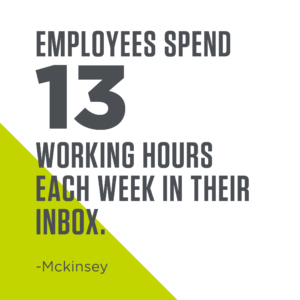When I first started out as an Account Manager, one of the hardest tasks to
master was managing the overwhelming amount of communication running past me. Don’t get me wrong—I love being the center of attention, but at times it was incredibly difficult to get ahead of my email inbox. It was clear I needed to find a system for organizing my email.
 I tried “inbox zero” and found that I was losing precious time making sure that my inbox was completely empty at all times. My inbox became a burden instead of making my job easier. Over the years, I developed a simple set of rules that turned my inbox from enemy to ally.
I tried “inbox zero” and found that I was losing precious time making sure that my inbox was completely empty at all times. My inbox became a burden instead of making my job easier. Over the years, I developed a simple set of rules that turned my inbox from enemy to ally.
8 Hard and Fast Rules I Live By:
1. Develop Your Own Organization
The best organization is the organization you know inside and out. I decided that creating my own was the best way to go. I create client or team folders, then organize by [project number]_[project title]. When an email doesn’t fit into a project number, they stay in the client folder grouped by year, then month. This may not work for you—and that is okay—but you must try different methods to determine what filing system works best for you.
2. Avoid Scrolling
Inbox zero isn’t always feasible, but keeping a clean inbox so you can see every message certainly is. Sometimes I struggle to keep this rule throughout the day, but I always make sure to start the next morning with a clean and manageable inbox.
3. To-do List
If the email is relevant and requires an action, leave it in your inbox. This turns your inbox into an automatic to-do list.
4. Move it
If an email isn’t relevant, doesn’t require an action or is just for your edification, then read it and move it to a folder or the trash. Letting useless emails clutter up your inbox is the easiest way to become overwhelmed by the enormity of cleaning it up.
5. Build a Habit
Schedule time for your inbox. Many of us jump to our email the second we get a notification, but this could be detrimental to our productivity. It can take up to 23 minutes to return to the task we were working on prior to checking that email. Block out 15 minutes every few hours and focus solely on email. Reducing the number of interruptions while working and checking your inbox will help you become more accomplished with your limited time.
6. Filters and rules RULE
Use them and love them. The average person receives 88 business emails a day. Out of the emails received, 12 of them are spam or irrelevant. Automatically eliminating those 12 will save you time and make your mailbox more manageable. Personally, I like all of my internal communication to go into one folder. Even though I love all the GIFs and fun stuff we talk about as a team, it can get overwhelming when everyone is replying “all”.
7. Bow out
If you aren’t reading that newsletter anymore, unsubscribe! Or set up a rule to have it automatically sent to a newsletters folder that you can read when you have time!
8. Lead by example
The most impactful rule I have is to send people the types of emails that you would like to receive.
I like my emails to contain:
- Action and topic in subject line (i.e.: Feedback Needed: Digital Creative)
- Provide a few sentences with context
- State the ask (what do you want them to do and by when?)
- SHORT and to the point
I’ve found that by simply formatting emails in a way I would like to receive them, my communication has become more effective and I am able to quickly identify where an email belongs.
You’ll be amazed at the time you get back when you are running your inbox rather than your inbox running you! You don’t have to spend days or hours cleaning up. Start with the emails you have coming in and figure out what will work for you. My rules are a simple place to start.
